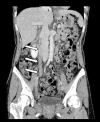Transient elevations of liver enzymes and ovarian vein thrombosis arising after total laparoscopic hysterectomy
- PMID: 30254917
- PMCID: PMC6135184
- DOI: 10.1016/j.gmit.2017.06.005
Transient elevations of liver enzymes and ovarian vein thrombosis arising after total laparoscopic hysterectomy
Abstract
Ovarian vein thrombosis in non-pregnant patient is a rare clinical entity. Among 170 patients who underwent total laparoscopic hysterectomy (TLH) in our hospital from December 2011 to December 2015, we have one case of ovarian vein thrombosis (0.0059%). A 42-year-oId woman had a fever of 39 °C on the fourth day after TLH. A blood test revealed elevations of liver enzymes and D-dimer (AST 1157 U/L, ALT 942 U/L and D-dimer >30 μg/L). Computed tomography (CT) scan with intravenous contrast agent demonstrated right ovarian vein thrombosis which caused decline in blood flow to liver and acute liver dysfunction. Low-molecular weight heparin was initiated and liver enzymes reduced rapidly. On the seventeenth day after TLH, CT scan revealed a recanalization of the ovarian vein. We report the clinical outcomes of the case attempted with a small review of the literature.
Keywords: Complications; Liver enzymes; Ovarian vein thrombosis; Total laparoscopic hysterectomy.
Conflict of interest statement
Conflicts of interest: The authors have no conflicts of interest relevant to this article.
Figures
Similar articles
-
Ovarian vein thrombosis after total laparoscopic hysterectomy with unilateral adnexectomy: A case report.Int J Surg Case Rep. 2017;41:1-4. doi: 10.1016/j.ijscr.2017.09.022. Epub 2017 Oct 4. Int J Surg Case Rep. 2017. PMID: 29017137 Free PMC article.
-
Ovarian vein thrombosis following total laparoscopic hysterectomy.Asian J Endosc Surg. 2012 Nov;5(4):179-82. doi: 10.1111/j.1758-5910.2012.00147.x. Asian J Endosc Surg. 2012. PMID: 23095296
-
Pulmonary thromboembolism as a result of ovarian vein thrombosis after laparoscopic-assisted vaginal hysterectomy for uterine myoma.J Obstet Gynaecol Res. 2016 Jun;42(6):743-747. doi: 10.1111/jog.12973. Epub 2016 Mar 16. J Obstet Gynaecol Res. 2016. PMID: 26990049
-
Mesenteric cysts and mesenteric venous thrombosis leading to intestinal necrosis in pregnancy managed with laparotomy: a case report and review of the literature.J Med Case Rep. 2017 Jul 7;11(1):184. doi: 10.1186/s13256-017-1320-5. J Med Case Rep. 2017. PMID: 28683785 Free PMC article. Review.
-
A case of portal vein thrombosis caused by blunt abdominal trauma in a patient with low protein C activity.Clin J Gastroenterol. 2018 Dec;11(6):507-513. doi: 10.1007/s12328-018-0879-8. Epub 2018 Jun 19. Clin J Gastroenterol. 2018. PMID: 29923164 Review.
Cited by
-
A retrospective study of 323 total laparoscopic hysterectomy cases for various indications and a case report treating caesarean scar pregnancy.J Med Case Rep. 2020 Dec 14;14(1):243. doi: 10.1186/s13256-020-02585-5. J Med Case Rep. 2020. PMID: 33308278 Free PMC article.
References
-
- Wijaya T, Lo TS, Jaili SK, Wu PY. The diagnosis and management of ureteric injury after laparoscopy. Gynecol Minim Invasive Ther. 2015;4(2):29–32.
-
- Sicam RVG, Huang KG, Magno ADL, Ueng SH. Laparoscopic and microscopic images of thermal injury to the ureter. Gynecol Minim Invasive Ther. 2016;5(1):45.
-
- See A, Chern B. Contained intra-abdominal morcellation: is it the way forward? Gynecol Minim Invasive Ther. 2016;5(3):99–101.
-
- Chin H, Ng XHA, Chen BSM. Power morcellation–An emerging risk complicating minimally invasive surgery for uterine mesenchymal neoplasms. Gynecol Minim Invasive Ther. 2016;5(3):109–111.
-
- Manvelyan V, Khemarangsan V, Huang KG, Adlan AS, Lee CL. Port-site metastasis in laparoscopic gynecological oncology surgery: an overview. Gynecol Minim Invasive Ther. 2016;5(1):1–6.
Publication types
LinkOut - more resources
Full Text Sources
Other Literature Sources

